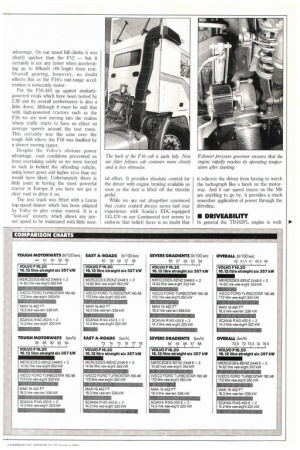The cyclonic action of the air filter is also designed to remove dirt and water before they enter the cylinders.
Page 32

Page 33

If you've noticed an error in this article please click here to report it so we can fix it.
Matched to the TD162FL there is a twin-plate clutch and the 14-speed SR2000 gearbox with splitter and range change. According to Volvo, 14 speeds are pretty much the optimum for regular haulage work at 38 tonnes, although maybe there's an element of "well they would say that wouldn't they" because they do not offer a 16 or 18-speed box.
Final drive is taken care of by Volvo's own RAEV91 single reduction axle with an air-operated diff-lock and 3.1:1 ratio (there is no other option on the 4x2 tractor). Put all that lot underneath the longserving Volvo F cab and you have this week's test tractor. The question is: What does it add up to?
The F16.485 is the fourth 298kW (400hp)plus tractor CM has tested in as many months, and already we're beginning to see a pattern emerging. Most are coming in with an average consumption of around the 42.2-39, 8-litres/100km (6. 7-7.1mpg) band with, not surprisingly, above average speeds. And the F16.485 is no exception.
A quick -look at our comparison charts shows just how well it does against its major rivals. It's also worth comparing it with the F12.400 which we tested last autumn. With its 291kW (395hp) and 1,680Nm (1,2831bft) of torque the F12.400 is Volvo's next most powerful tractor.
Over our three-day test the F16 proved to be only marginally quicker than the F12 — averaging 72.9kmili (45.2mph) against 72.5km/h (45.0mph) — and with a thirstier average consumption of 42.21it/ 100km (6.69mpg) compared with the F12's 39. 81it/100km (7.21mpg).
Anyone who is alarmed at the Flfi's economy can at least be reassured that on motorway and on A-road running it sips dery a little slower. On the A74 between Gretna and Hamilton it managed a respectable 36.61it/100km (7.72mpg). But make no mistake all that power does not come for nothing.
At the time of testing the F12 we asked whether the F16's extra power really could be justified, given the congested state of the roads and the high cost of fuel. Judging by its test results it is difficult not to say no.
Where the F16.485 should score over its 12-litre stablemate is in outright performance, not least due to its massive torque advantage. On our timed hill climbs it was clearly quicker than the F12 but it certainly is not any faster when accelerating up to 80km/h (49.7mph) from rest. Overall gearing, however, no doubt effects this as the F16's mid-range acceleration is noticeably faster.
Put the F16.485 up against similarlypowered rivals which have been tested by CM and its overall performance is also a little down. Although it must be said that with high-powered tractors such as the F16 we are now moving into the realms where traffic starts to have an effect on average speeds around the test route. This certainly was the case over the tough A68 where the F16 was baulked by a slower moving tipper.
Despite the Volvo's obvious power advantage, road conditions prevented us from overtaking safely so we were forced to tuck in behind the offending vehicle, using lower gears and higher revs than we would have liked. Unfortunately there is little point in having the most powerful tractor in Europe if you have not got a clear road to drive it on.
The test truck was fitted with a Lucas top-speed limiter which has been adapted by Volvo to give cruise control. It is a "foot-on" system, which allows any preset speed to he maintaned with little men tal effort. It provides absolute control for the driver with engine braking available as soon as the foot is lifted off the throttle pedal.
While we are not altogether convinced that cruise control always saves fuel (our experience with Scania's EDC-equipped 143.470 on our Continental test seems to endorse that belief) there is no doubt that it relieves the driver from having to watch the tachograph like a hawk on the motorway. And if our speed traces on the M6 are anything to go by, it provides a much smoother application of power through the driveline.
























































































